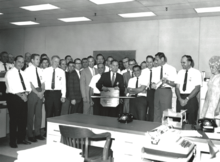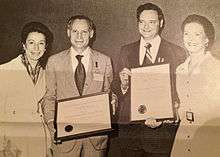Harry Dornbrand
| Harry Dornbrand | |
|---|---|
 Harry Dornbrand and his wife Mildred. | |
| Born | November 10, 1922, Birthplace: Brooklyn, New York |
| Nationality | United States of America |
| Occupation | Aerospace Engineer |
| Spouse(s) | Mildred F. Bernstein |
| Awards | NASA Distinguished Public Service Medal |
Harry Dornbrand (born November 10, 1922) is an American Aerospace Engineer. He was a leading figure in the development of satellite technologies during the space-race era. He served as Vice President, then President of Fairchild Industries Space and Electronics division,[1][2][3] Vice President of Fairchild Industries (the parent corporation),[4] and President of American Satellite Corporation,[5][6] a Fairchild subsidiary. The technologies and projects he managed for Fairchild and NASA in the 1960s and 1970s were crucial to the advancement of satellite technology worldwide and pioneered satellite television broadcasting and orbital scientific experimentation. He was a member of the American Institute of Aeronautics and Astronautics. In 1974 he was awarded the NASA Distinguished Public Service Medal for his success managing the ATS-6 satellite program.[3][7][8]
Early life
Harry was born in Brooklyn on November 10, 1922 to a family of Jewish European immigrants. His father Morris had arrived on Ellis Island in 1890 from Rohatyn, in what was then Austria-Hungary. Like his father, Morris worked as a seasonal sweatshop operator, sewing pockets on vests in Lower Manhattan during the era of the Triangle Shirtwaist Factory fire. Harry enrolled at City College as a student of engineering, and graduated in 1944 with a Bachelor of Science in Mechanical Engineering.[2][9][10] During his time at City College he worked as a paper boy, delivering the New York Times to buildings at the college.
After graduating he enrolled in the United States Navy and was sent to the Moffett Field Naval Air Station to do research for NASA's predecessor, the National Advisory Committee for Aeronautics.[1] He published two technical research papers[2] (listed here). While working his first civilian job after World War II, Dornbrand earned a master's degree in Mechanical Engineering from Columbia University in 1953.[2][10] He married Mildred F. Bernstein, a graduate of Brooklyn College with a degree in Biology, and they had three children, Phyllis, Faith, and Carol Lynn.
Career

During his time in the United States Navy, Dornbrand specialized in heat transfer, thermodynamics, and fluid flow research with NACA, at the Ames Aeronautical Laboratory.[3][10] In 1946 he began work at Republic Aviation in Long Island, New York, where he was manager of space systems technology.[10] During his 20 years there he held management positions on the FIRE system, Advanced Orbiting Solar Observatory, Synchronous Meteorological Satellite and Manned Orbital Laboratory programs.[10] Republic was purchased by Fairchild Hiller in 1965 and Dornbrand moved to Fairchild's Germantown, Maryland facility.
Fairchild and American Satellite Corporation
In 1966, Dornbrand joined Fairchild Industries Space and Electronics and worked as a Project Manager until 1973, when then-President Wilbur Pritchard elevated him to the rank of Vice President.[2] During his time at Fairchild he facilitated the design and launch of multiple aerospace projects, the most notable of which were satellites in the Applications Technology Satellite series commissioned by NASA. Following the success of the ATS-6, Dornbrand became President of Fairchild Space and Electronics in 1975.[3] In 1976 he was appointed President of American Satellite Corporation,[6] a subsidiary company of Fairchild.

While Dornbrand was a Program Manager and Assistant General Manager of Fairchild Space and Electronics Division, NASA contracted Fairchild to oversee the creation of the ATS-6 and ATS-7 (also known as ATS-F and ATS-G) satellites, and he was appointed to be manager of both projects.[10][11] The ATS-6 satellite was the most powerful telecommunications satellite of its time, the first Direct Broadcast Satellite, the first educational satellite, and the first 3-axis stabilized spacecraft in geostationary orbit, among other accolades.[12] It received high praise from NASA, and in 1975, Dornbrand along with other chief Fairchild representatives including Wernher von Braun demonstrated its ability to aim broadcast signals at any part of the United States, a technological breakthrough at the time.[13]
NASA originally commissioned a seventh satellite in the ATS series, but despite the construction of an ATS-G prototype, the project was never completed. In a 1976 article of the Fairchild World journal, Dornbrand said that due to the success of ATS-6 and "because the ATS-6 satellite gives promise of lasting for many more years than originally expected, NASA cancelled the second spacecraft".[14] ATS-G (the second satellite) sat for some years in a Fairchild lot, and was later donated to the Smithsonian National Air and Space Museum.
Publications
- Technical specifications for the ATS-6 satellite written by Harry Dornbrand. NASA Technical Reports.
- Infrared Defrosting and Deicing, 1952. Worldcat.
- Theoretical and Experimental Study of Vortex Tubes, 1950. Worldcat.
Awards
For his work with NASA leading the ATS-6 project, Dornbrand received the NASA Distinguished Public Service Medal, the highest honor awarded to a non-government employee by that organization.[3]

See also
References
- 1 2 Shapiro, Ralph (September 1, 2012). From NYC Lower East Side to NASA Satellite Operations Manager. Xlibris Corporation. p. 62.
- 1 2 3 4 5 "Four Named Vice President In Space, Electronics Co.". Fairchild World. 10 (7): 1. July 1973.
- 1 2 3 4 5 "President, Two V.P.s Appointed at Fairchild Space & Electronics Co.". Fairchild World. 12 (4): 3. August 1975.
- ↑ "Five Men Are Elected Vice Presidents". Fairchild World. 14 (2): 1, 6. February 1977.
- ↑ "Who's Where". Aviation Week & Space Technology: 11. December 13, 1976.
- 1 2 "Dornbrand Named President of American Satellite Corp.". Fairchild World. 13 (12): 2. December 1976.
- ↑ "Award Winners and Proud Wives". Fairchild World. 11 (6): 1. December 1974.
- ↑ NASA Historical Data Book, Vol. 4. Scientific and Technical Information Division, National Aeronautics and Space Administration. 1988. p. 400.
- ↑ "Class of 1944" (PDF). City College Fund. Retrieved November 24, 2014.
- 1 2 3 4 5 6 "ATS Manager Experienced". Fairchild World. 9 (11): 2. November 1972.
- ↑ Dornbrand, Harry. "Applications Technology Satellite 6 - Upgrading the life style of millions of people.". NASA Technical Reports Server. Retrieved November 10, 2014.
- ↑ "Fairchild thanks the ATS-F team". The Wall Street Journal. June 13, 1974.
- ↑ "Fairchild Awarded High Marks by NASA". Fairchild World. 12 (1). February 1975.
- ↑ "Bicentennial Forecast Report". Fairchild World. 13 (1): 4. January 1976.